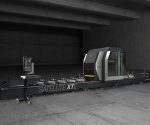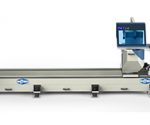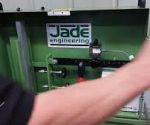Elumatec UK
Address: Unit 1 Integra, Thornton Chase, Linford Wood, Milton Keynes, MK14 6FD
Tel: 01908 580 800 – Email: sales@elumatec.co.uk – Website: https://www.elumatec.com
Key Contacts:
Neil Parton – Managing Director
The healthcare of production assets

Like the footballer who needs time on the physio’s bench if he’s to be ready for the next match, machinery performs better, lasts longer and is more reliable with regular TLC, believes Neil Parton of Elumatec
Decisions about acquiring production assets are often made after lengthy consideration. Buyers look at whether the proposed equipment will deliver the desired output rates and standards of precision, and whether it will complement the operation’s existing infrastructure – all critical factors. With quality and production efficiency key drivers, it’s easy to see how the less exciting notions of machine lifespan and reliability can become secondary considerations. They shouldn’t be. They should be right up there in the decision-making process.
If we leave the shop-floor and head over to the sports field, we’ll find numerous examples of individuals with the speed, power and accuracy they need to excel in their game. They can be great team players too, just what the squad needs. But many of these people fail to realise their potential. They suffer injury and breakdown, either because they fail to pay enough attention to their nutrition, rest and recovery or because they used their bodies – their assets – unwisely.
We understand these issues when they occur in people, but we can forget that machinery too needs careful management. We can get very excited about phenomenal processing speed or record- breaking output while ignoring the build-up of problems in an asset. An athlete can complain of fatigue, but a machine hasn’t got that capability. A skilled operator may hear something not running true, but when the imperative is to meet this month’s production targets, the warning signs can be ignored.
This is a dangerous situation, but it’s the way many organisations operate. Production assets are very often a scarce resource in a system and management must balance multiple competing, demands. Often, they scrape by – on a wing and a prayer – hoping that their machinery will keep going until a vital order is completed. Occasionally, they suffer a breakdown and all the costs and consequences of downtime. And although unplanned downtime can be seen as a risk worth taking, an extended period without production capacity can easily erode all the positive effects of faster processing times, not to mention the implications for customer service.
Low-maintenance assets are better than no-maintenance assets – Often, we get into discussions with potential buyers looking for machinery where they won’t need to worry about breakdowns or maintenance. It can be a tricky conversation because although elumatec is known for the durability and reliability of its equipment, that long-term performance is a result not only of the engineering but also of our preventative maintenance.
As engineers, we have a fascination with machinery. It goes beyond that of many who see a production asset as a means to an end. I’m not saying we see a machine as a living, breathing entity, but rather as something to be cared for and respected. Like the footballer who needs time on the physio’s bench if he’s to be ready for the next match, machinery performs better, lasts longer and is more reliable with regular TLC. Success in the sporting arena requires a proactive approach to maintaining the body. In manufacturing, however, there can be a reluctance to even think about these things.
An effective preventative maintenance plan should be part of every manufacturer’s strategy. This should identify critical machinery, include details of maintenance requirements and an optimal schedule of inspection and maintenance work. The keyword here is optimal – no one is suggesting that unnecessary work should be carried out as part of a routine, box-ticking exercise. If anyone questions the wisdom of having such a plan in place, I’d suggest they spend some time calculating the cost of downtime or a machine limping along at half capacity. And it’s not just downtime costs that need to be factored in. A poorly maintained machine could be a health and safety risk. It could be compromising the quality of your output, increasing scrap rates and rework. It could even be damaging the machine itself, turning your precious asset into a liability.
A team effort – You could think of a machine as needing its own healthcare team: the operator, your inhouse maintenance team, external specialists. There’s monitoring, routine protection, regular checks and a plan for replacing key components before they cause issues. The best machinery – and I’ll admit to thinking about elumatec’s products here – is built to be both reliable and fixable. It’s expected that parts will need replacing or that adaptations may be required to suit changing demands. That’s not a weakness. It’s a strength. It’s how assets avoid the crash and burn. it’s how they keep on performing, year after year, to a ripe old age.











